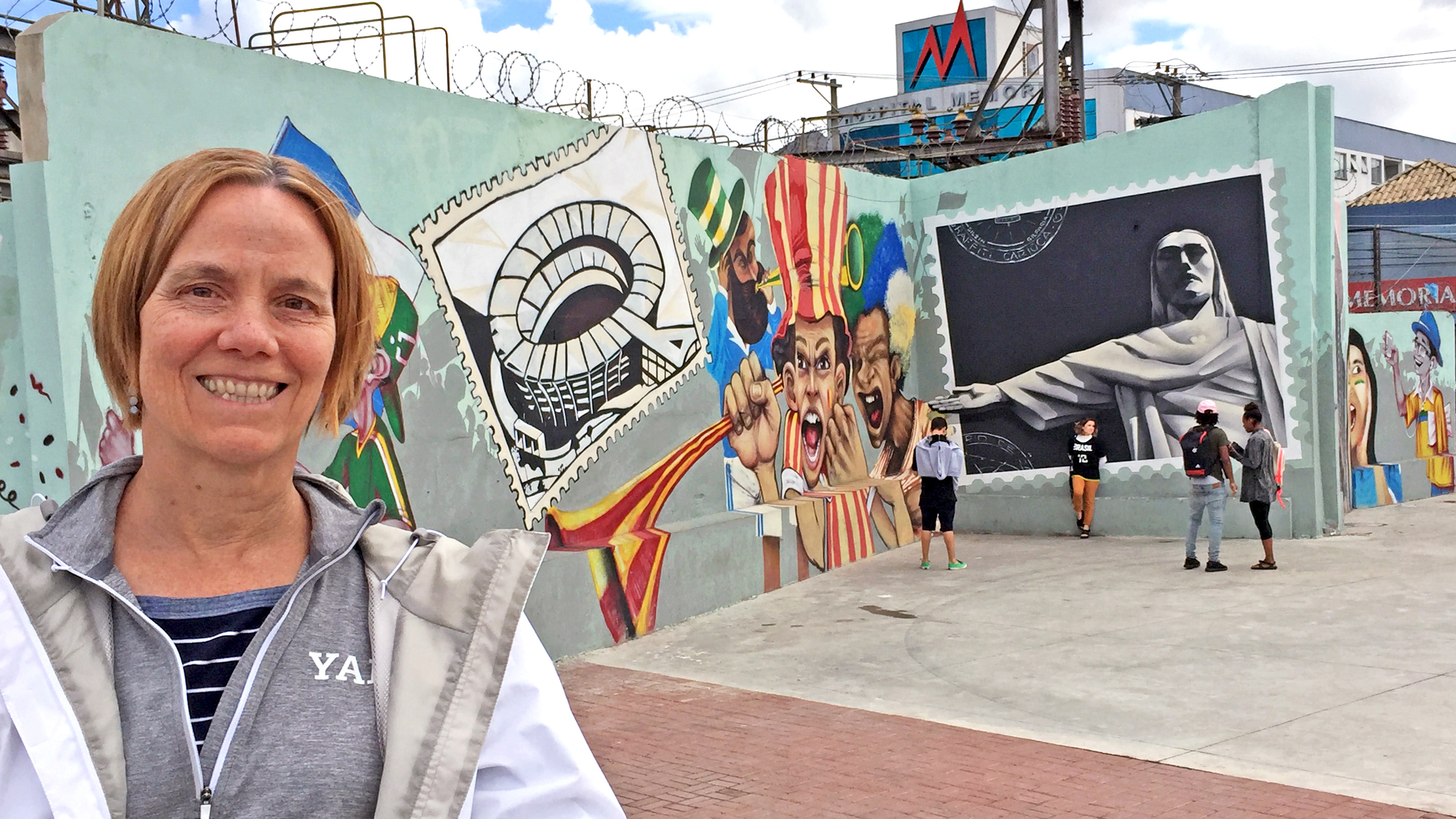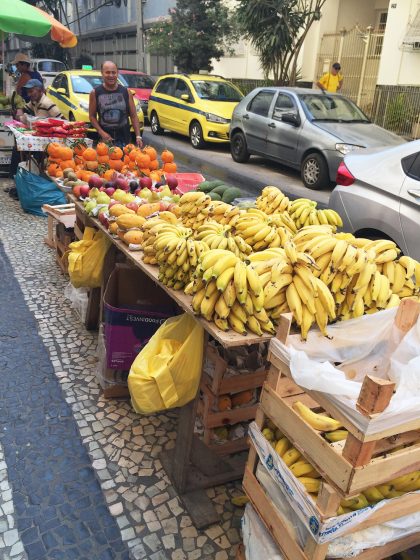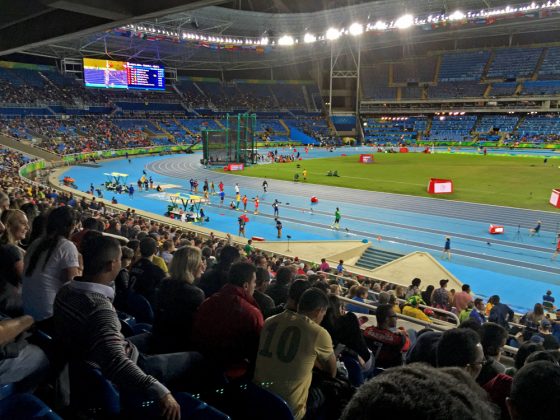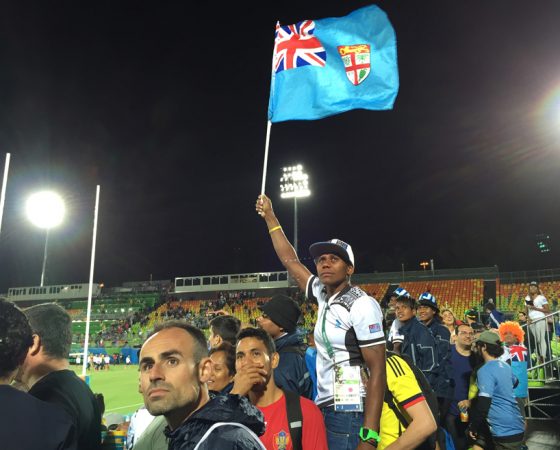
As a UMSL anthropology professor and the author of “Beijing’s Games: What the Olympics Mean to China,” Susan Brownell was able to find unique perspectives on the 2016 Olympics in Rio. Here she stops to snap a photo of street art on her way to the Olympic stadium. (Photos courtesy of Susan Brownell)
Susan Brownell believes immersion is one of the best research methods.
“If you want to understand another human being, you need to talk to them and observe their daily life,” said the University of Missouri–St. Louis anthropology professor.
Through travel, conversation and everyday interactions, Brownell has been able to enjoy international events while applying her trained, investigative eye to questions of culture, socioeconomics and ethnocentrism.
For her latest project, “Sport Mega-Events and Global Political Economy,” a series of essays about the 2016 Olympics in Rio co-authored with Niko Besnier and published by SAPIENS, Brownell visited Rio, Brazil, to gain a better understanding of the games and what they mean to people around the world.
UMSL Daily caught up with the sports culture expert to discuss the insights she gained from attending the 2016 Olympic games.

Susan Brownell observed that everyday life continued in Rio during the Olympic games, and street vendors sold fresh fruit daily.
What were your impressions of the culture in Rio?
It’s just very human. The people were the most polite I have ever encountered. The crowds were very well-mannered. If someone bumped into you, they apologized. They gave up their seats to older people on the public transportation, and they were very assertive about warning you that your bag was open and that you should be careful of thieves. While the people were very nice, I was a bit intimidated by the food at first.
The food was unusual for me. There were shops and street side stands loaded with fruits and vegetables – particularly tubers, melons and greens – that I had never seen before. Fortunately our maid Celia cooked up all kinds of delicious dishes for us. I would not have known what to do without her.
Long before the games started, there were concerns of crime in Rio. Did you find those concerns to be valid or a bit overblown?
I live in the city, and I am accustomed to thinking about general safety, like making sure doors and windows are locked and being aware of surroundings. In Rio, I stayed in the apartment of a fellow anthropologist in the Flamengo neighborhood, which is an upscale neighborhood near Flamengo Beach, one of the nicest beaches.
I walked the streets of the neighborhood at all hours and never felt unsafe. My Rio academic colleagues told me that they do not worry much about crime in their everyday lives. On the other hand, most of the nice apartment buildings in Rio are fronted by a tall, barred gate and then have a door into the building that is watched by a doorman most of the day.
Though common crime wasn’t a concern where I stayed, there was a huge military presence at the games. Soldiers in fatigues holding long guns were seen everywhere. It is normal in Latin America to see soldiers in key locations, but their numbers were vastly multiplied for the games. The torch relay was led by what looked like a military convoy – not exactly a symbol of peace!
If your stay felt safe in general, what might account for fears of crime?
Rio is a highly segregated city because the worst crime areas, the slums known as favelas, are nestled in deep valleys high on the mountain slopes and are often controlled by drug lords. The police don’t dare to enter. In the years leading up to the games, the government had attempted to “pacify” many of them by sending in specially trained military squads.
In 2012 I had spent half a day wandering around the biggest one, Rocinha, right after it had been occupied. There were several stories about cars that got lost using GPS which ended up in a favela. It happened to a colleague of mine from Greece, who found the car surrounded by hundreds of people. However, they were friendly and no harm was done.

The Nilton Santos stadium pictured here hosted all track and field events for the 2016 Olympics and can seat up to 60,000 spectators.
How did the Rio Olympics compare to previous Olympics?
This was the fifth Olympics I’ve attended, after Los Angeles 1984, Atlanta 1996, Athens 2004 and Beijing 2008. Rio was most similar to the other American Olympics. Los Angeles and Atlanta were “cheap Olympics” that didn’t build a lot of permanent facilities. Like downtown Los Angeles and Atlanta, Rio is slightly gritty and chaotic. At almost every competition and in public gatherings there were organized protests against the current interim president, Michel Temer, who is accused by some of coming to power through an illegitimate coup. Due to its budget crisis, a large number of the Rio venues were temporary grandstands draped with fabric and lighted to dress them up a little. In real life they were a bit shabby, so when I got back home and saw the NBC broadcast I was surprised that they made the city look a lot more glamorous than it does in real life.
There wasn’t a lot of decoration around the city at first. The presence of the Olympics was hard to detect. However, over time the local people got into it. People started watching the sports on the televisions at all the bars. Realizing that fans were coming to sit and watch, the bars started decorating themselves with Brazilian or world flags. The “Olympic Boulevard” near the renovated port area became packed with people. The city slowly became more “Olympic” over time as the populace got into the mood. Brazilians are sports-crazy, and the cheering for the Brazilian athletes at the different sports events was the loudest I’ve ever heard – it was deafening.
How did international attention impact the economy of Rio?
Rio had a very interesting development that you probably didn’t hear about on TV. It was the topic of my research. At every Olympic Games, countries and corporations stage “hospitality houses” where athletes can hang out, citizens can watch their teams on the big screen and celebrate, and corporate products can be promoted. This practice exploded in Rio, with more than 30 national houses. Corporations like Coca-Cola, Omega and even the National Basketball Association, had big operations. And they were very popular, with people waiting in line for several hours to get in. Having studied the 1904 St. Louis World’s Fair and attended the modern version – the World Expo – in Shanghai in 2010, I saw that these houses are starting to resemble the national and corporate pavilions at world’s fairs. Countries have exhibitions showing off their national culture, advertising tourism and showcasing products.

A member of Fiji’s women’s rugby team waves the country’s flag after t Fiji’s men’s rugby team took the gold medal in a heated match against Great Britain.
I was able to get into the exclusive house of the Swiss watchmaker Omega, an Olympic sponsor. It had posh decorations and a whole darkened “moon room” devoted to Buzz Aldrin’s walk on the moon in 1969, when he wore an Omega. These houses were so popular that I think we’ll see more of them in the future. It’s a win-win situation because they pour revenue into the host city, and they advertise countries and products to the visitors.
As an anthropologist and sports fan, what was your favorite Olympic moment?
It is always a treat to see a small country step up and take a medal from a sports power. Seeing Fiji win the men’s rugby sevens gold medal in its match against its former colonial master, Great Britain, was inspiring. It was Fiji’s first-ever Olympic medal since it first joined the games in 1956, and it was a gold medal in a sport that is very popular around the world. The sport is very exciting and fast-moving. Most Americans probably don’t realize that Fiji is actually a world power in rugby, which was just added to the Olympics this year.
Almost all indigenous Fijian men grow up playing it, and many immigrate to Europe and Japan to play it professionally. My collaborator, Niko Besnier, has been conducting fieldwork on rugby in Fiji and speaks Fijian. There was a small and very colorful group of fans at the end of the stadium that included two drag queens in full costume. Many of the fans wore bright blue wigs. The Fijian women’s team were there, some of whom are notable for their own gender-bending. The diversity of gender expression and the enthusiasm in that group was very interesting.















